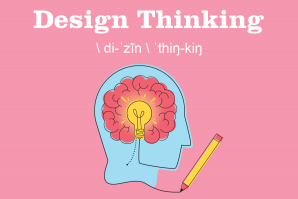Marra DeGraff and Adrian Vazquez have an unusual way of finding creative solutions and encouraging innovation in the workplace. They laugh. They play. They goof around. And they encourage everyone else in the room to do likewise.
Bumbling and fumbling — not having all the answers — are good things too, at least for a time, they say. In fact, embracing “clashing perspectives” is something that’s encouraged.
DeGraff, who is based in Sacramento, and Vazquez, the cofounders of InterTidal, use design thinking to help improve workplaces. They see design thinking as a way to solve crucial problems that might be holding companies and agencies back, whether the challenge is how to have more productive meetings or how to come up with the right product design to win over their target customer.
Design thinking, one of the hottest methodologies when it comes to innovation, is embraced by many business leaders as a way to deal with the complex and competitive 21st-century workplace. But there are critics who say the process can be misunderstood or misused by those who simply go through the motions without doing the required deep dives to arrive at new and profound solutions. And some suggest good old-fashioned brainstorming and conceptualizing work just fine too.
One of the challenges is figuring out what design thinking is. Is it just another form of brainstorming? Researching and responding to consumer demand? Getting constructive feedback on new designs? It’s all that and then some, with an emphasis on welcoming new — and often unusual — ideas without someone else immediately shooting them down.
“Design thinking basically is a creative methodology for solving problems,” says DeGraff, who learned the approach at Stanford University’s D.school. “It is inherently human-centered — sometimes it is referred to as
human-centered design. It starts with the end user in mind. There’s a bias toward action, so you start with prototyping early, getting things made out of inexpensive materials into people’s hands early on to gather feedback and then iterate from there. It’s a design process where instead of sitting in a room for months or years and spending millions of dollars on research and talk to make a final product, you prototype early on and get user feedback.”
Yes, iterate — to say or do again and again — is a word you’ll likely have on the tip of your tongue if you want to get design thinking — and its lingo — down pat. In countless treatises on design thinking, iterate comes up, well, again and again.
The idea of the prototype is key to design thinking. Non-designers can get in on the action too. You can make a model, write a story, create a workflow chart and so on. The idea is to get the prototype out there and gather all kinds of feedback before proceeding.
“You can prototype anything. You can prototype processes,” DeGraff explains.
“Instead of drawing it up on the board, you can get people to act it out,” adds Vazquez, who has an undergraduate degree from Bard College and taught improvisational theater at UC Berkeley.
Using Humor to Unlock Creativity
Leena Riggs, marketing manager for Visit Rancho Cordova, says her agency hired InterTidal after experiencing DeGraff’s approach at a board of directors retreat a year earlier. “She really challenged the way our board members (approach) problems and think things through,” says Riggs. “We knew we wanted to bring her back.”
During the InterTidal experience, tourism general managers and sales associates soon found themselves doing and saying things in unconventional ways. An exercise that began with someone portraying a falling leaf led to Riggs jumping into a circle as a pumpkin, followed by another colleague stepping up as a witch. And, no, this was not summer camp for middle school kids. Another exercise had participants write down their assumptions about others and physically push away the pieces of paper — they were invited to shred or burn them later.
“The exercises they do don’t seem related at first,” says Riggs, “but they help create a secure environment because we’ve all just been a little silly and a bit more vulnerable.”
When it came time to brainstorm, at the urging of DeGraff and Vazquez, the mindset had shifted from “OK, but” to “Yes, and.”
To DeGraff and Vazquez, using improv is simply a way to explore, discover and gather ideas — and getting clients to loosen up enough to say and do things outside their comfort zones.
“Instead of being the kind of consultants who come in and say, ‘This is what’s wrong,’” DeGraff says, “we come in and say, ‘Let’s find what’s wrong. You all know what’s wrong or can figure it out.’ We’re leveraging many brains in the room instead of one Ivy League grad (from a more traditional consulting firm).”
The Origins of Design Thinking
Any discussion of design thinking usually circles back to Ideo, the global design and consulting company cofounded in 1991 by Stanford professor David Kelley. Ideo is widely credited with popularizing design thinking, and the company helped spearhead the formation of the influential D.school at Stanford, where the methodology is taught to college students and professionals alike. The company says design thinking has three essential pillars.
-
Empathy: getting to know the needs of those
who you’re designing for
-
Ideation: generating plenty of ideas
- Experimentation: testing those ideas, most often via a basic and inexpensive prototype of some kind
If it is well-executed, design thinking can lead to innovative solutions. According to Ideo, you start with a key question, then gather inspiration, and push past obvious solutions until you arrive at a breakthrough. Design thinking is anything but easy. It requires plenty of thinking and action, aka iterating.
Design thinking isn’t the only way to be innovative, and there is no shortage of critics. In a recent essay on Medium.com by Lee Vinsel, a professor at Virginia Tech’s Department of Science, Technology, and Society, titled “Design Thinking is Kind of Like Syphilis — It’s Contagious and Rots Your Brains,” he writes that being confused about design thinking “is a common reaction to a ‘movement’ that’s little more than floating balloons of jargon, full of hot air.”
Responding to criticisms, Ideo partner Michael Hendrix says in a 2018 Fast Company story that many people use the methodology in superficial ways, and work cultures that don’t foster trust are bound to fail somewhere along the
design-thinking paths. “There is a real need to build respect for one another and trust in the safety of sharing ideas so you can move forward,” Hendrix says in the story. “Knowing when to bring judgments is important. Cultures that are highly judgy, that have hierarchy, that are rewarding the person who is the smartest person in the room, don’t do well with this kind of methodology.”
Linda Naiman, founder of Vancouver, British Columbia-
based Creativity at Work, recently was in Sacramento to teach design thinking to board members of a professional association, which she declined to identify. “They have challenges in their industry, and some of what they do is lobby to the government,” Naiman says. “They have complex problems and are thinking about the future. They wanted to learn about design thinking because it is future focused.”
Naiman has consulted for Fortune 500 companies, the U.S. Navy and international government agencies since the mid-1990s through her company, and she says companies such as Cisco Systems, IBM and Proctor & Gamble have delved heavily into design-thinking protocols.
“These organizations are looking for what is going to give them a competitive advantage,” Naiman says. “Arts-based learning is a way to access different capacities in the brain that may have been dormant because of our linear, left-brain way of learning. The reason design thinking has become so popular over the past 20 years is major companies noticed that design firms were doing well and that they’re good at innovation. They wouldn’t be at the top of their game without being innovative, and in order to be innovative, you have to be creative. Part of what makes you creative and being an innovator is having the ability to ask good questions, observe the world around you and discover nonobvious patterns.”
Design Thinking Aims to Solve Problems
That’s what Vazquez of InterTidal is getting at when he leads an improv session. Often, he’s warned ahead of time that the employees in the workshop are unlikely to let loose with comedic, sometimes silly, sketches in front of a crowd.
“If I’m coming in, and I’ve scripted everything out and have a bunch of exercises that don’t take full advantage of their creativity because I’m afraid that I’m going to make them super-uncomfortable, they’re going to get less out of the workshop,” Vazquez says.
Asked about his improv approach, Vazquez explains, “I usually ask groups to do some simple camp games — try to clap once at the same time as the person right next to you — now they’re ‘it’ and pass to the person right next to them by trying to clap at the same time … all the way around the circle.”
He also does paired exercises that focus on affirming and building on what the last person said. For example, “After whatever your partner says, you’ll say the words ‘Yes, and,’ then something that makes grammatical sense. You’re agreeing and adding something to what they did,” Vazquez says.
Missy Anapolsky, founder of the Sacramento-based communications agency Circle Design and an adjunct professor at Sacramento City College, has been a proponent of design thinking for years and has taught numerous workshops. She helped spearhead the creation of the SCC Makerspace a few years ago as an interdisciplinary hub that uses design thinking to solve problems and innovate.
“The core of this process is you keep the end users front and center all the time,” she says. After that, the ideas are bound to start flying, as long as there isn’t a critic who puts a halt on creative expression.
During one project at the Makerspace, for instance, Anapolsky says students came up with 360 ideas for the problem they were assigned to solve. “We were encouraging,” she says. “Nothing is wrong at this point. You don’t want to stifle anyone at this point because you want them to think outside the box.”
Then comes the hard part — winnowing the ideas and arriving at a solution. When that happens, it’s time to build a prototype and seek feedback.
“I do think everybody can benefit from design thinking,” Anapolsky says. “With many of my clients (through Circle Design), we talk about going through the process and problem solving. In a corporate environment, things have changed, and people recognize the value of the creative process and the process of problem solving.”
Recommended For You

Buzzwords: Design Thinking
A methodology that provides a solution-based approach to solving problems.
Various iterations of “design thinking” have come into play over the years, but the process as we currently know it consists of five steps: empathize, define, ideate, prototype and test.




Comments
I'm an instructor at California State University, Sacramento looking for a design thinking guest speaker for my EMBA Managing Creativity and Innovation course. Are you or do you know of someone in the Sacramento area or an association for design thinking talent interested in the gig? Please RSVP. Thanks.
Best,
Joe
Adjunct Management Professor